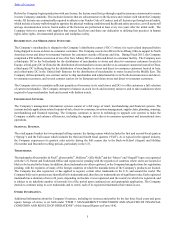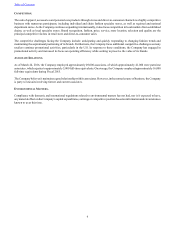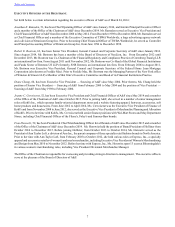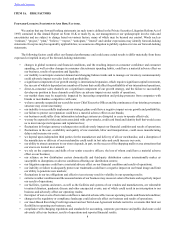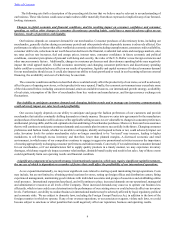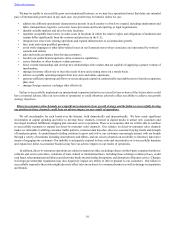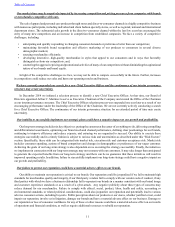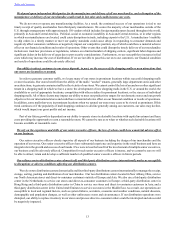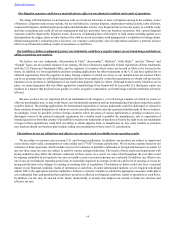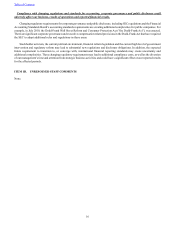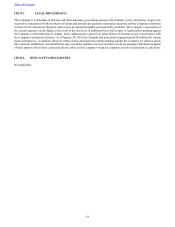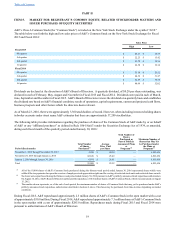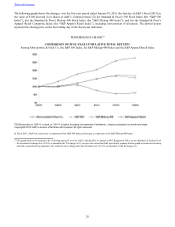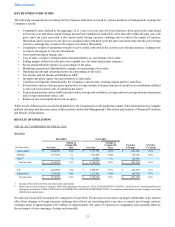Abercrombie & Fitch 2015 Annual Report Download - page 15
Download and view the complete annual report
Please find page 15 of the 2015 Abercrombie & Fitch annual report below. You can navigate through the pages in the report by either clicking on the pages listed below, or by using the keyword search tool below to find specific information within the annual report.
Table of Contents
15
Extreme weather conditions and the seasonal nature of our business may cause net sales to fluctuate and negatively impact
our results of operations.
Historically, our operations have been seasonal, with a significant amount of net sales and operating income occurring in the
fourth fiscal quarter. Severe weather conditions and changes in weather patterns can influence customer trends, consumer traffic
and shopping habits. Unseasonably warm temperatures in the winter or cool temperatures in the summer may diminish demand
for our seasonal merchandise. In addition, severe weather can also decrease customer traffic in our stores and reduce sales and
profitability. As a result of this seasonality, net sales and net income during any fiscal quarter cannot be used as an accurate
indicator of our annual results. Any factors negatively affecting us during the third and fourth fiscal quarters of any year, including
inclement weather, could have a material adverse effect on our financial condition and results of operations for the entire year.
Our facilities, systems and stores, as well as the facilities and systems of our vendors and manufacturers, are vulnerable to
natural disasters, pandemic disease and other unexpected events, any of which could result in an interruption to our business
and adversely affect our operating results.
Our retail stores, corporate offices, distribution centers, infrastructure projects and direct-to-consumer operations, as well as
the operations of our vendors and manufacturers, are vulnerable to damage from natural disasters, pandemic disease and other
unexpected events. If any of these events result in damage to our facilities, systems or stores, or the facilities or systems of our
vendors or manufacturers, we may experience interruptions in our business until the damage is repaired, resulting in the potential
loss of customers and revenues. In addition, we may incur costs in repairing any damage which exceeds our applicable insurance
coverage.
The impact of war or acts of terrorism could have a material adverse effect on our operating results and financial condition.
The continued threat of terrorism and the associated heightened security measures and military actions in response to acts of
terrorism have disrupted commerce. Further acts of terrorism or future conflicts may disrupt commerce and undermine consumer
confidence and consumer spending by causing domestic and/or tourist traffic in malls and the Company's flagship and other stores
to decline, which could negatively impact our sales revenue. Furthermore, an act of terrorism or war, or the threat thereof, or any
other unforeseen interruption of commerce, could negatively impact our business by interfering with our ability to obtain
merchandise from foreign manufacturers. Our inability to obtain merchandise from our foreign manufacturers or substitute other
manufacturers, at similar costs and in a timely manner, could adversely affect our operating results and financial condition.
Changes in the regulatory or compliance landscape could adversely affect our business and results of operations.
We are subject to numerous laws and regulations, including customs, truth-in-advertising, securities laws, consumer protection,
general privacy, health information privacy, identity theft, online privacy, employee health and safety, international minimum
wage laws, unsolicited commercial communication and zoning and occupancy laws and ordinances that regulate retailers generally
and/or govern the importation, intellectual property, promotion and sale of merchandise and the operation of retail stores, direct-
to-consumer operations and distribution centers. Laws and regulations at the state, federal and international levels frequently
change, and the ultimate cost of compliance cannot be precisely estimated. If these laws and regulations were to change, or were
violated by our management, associates, suppliers, vendors or other parties with whom we do business, the costs of certain
merchandise could increase, or we could experience delays in shipments of our merchandise, be subject to fines or penalties,
temporary or permanent store closures, increased regulatory scrutiny or suffer reputational harm, which could reduce demand for
our merchandise and adversely affect our business and results of operations. Any changes in regulations, the imposition of additional
regulations, or the enactment of any new or more stringent legislation including the areas referenced above, could adversely affect
our business and results of operations.
Our Asset-Based Revolving Credit Agreement and our Term Loan Agreement include restrictive covenants that limit our
flexibility in operating our business.
Our Asset-Based Revolving Credit Agreement, as amended, expires on August 7, 2019 and our Term Loan Agreement, as
amended, has a maturity date of August 7, 2021. Both our Asset-Based Revolving Credit Agreement and our Term Loan Agreement
contain restrictive covenants that, subject to specified exemptions, restrict our ability to incur indebtedness, grant liens, make
certain investments, pay dividends or distributions on our capital stock and engage in mergers. The inability to obtain credit on
commercially reasonable terms in the future when these facilities expire could adversely impact our liquidity and results of
operations. In addition, market conditions could potentially impact the size and terms of a replacement facility or facilities.


